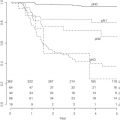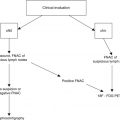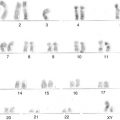Fig. 12.1
Response of neoadjuvant chemotherapy for fixed inguinal lymph nodes in the right groin showing central necrosis
Neoadjuvant Treatment
Leijte et al., in a retrospective case series, reported a clinical response in 12 out of 19 patients after neoadjuvant chemotherapy with different dual- or triple-drug regimens (vincristine/bleomycin/methotrexate, cisplatin/bleomycin/methotrexate, cisplatin/5-FU or cisplatin/irinotecan) [19]. Following salvage lymphadenectomy eight patients achieved long-term survival. Pagliaro et al. used neoadjuvant paclitaxel/cisplatin/ifosfamide chemotherapy in 30 patients and reported a clinical response in 15 with histologically confirmed complete remissions in three cases and long-term survival in nine [22]. Pizzocaro et al. reported neoadjuvant paclitaxel/cisplatin/5-FU chemotherapy for three patients with a clinical response in all three cases [21]. Relevant studies for neoadjuvant chemotherapy are summarized in Table 12.1.
Table 12.1
Neoadjuvant chemotherapy
Drug | Regimen | No. of cycles | No. of patients | Response | Complete response | Treatment-related death | Median survival (months) | Reference |
|---|---|---|---|---|---|---|---|---|
Cisplatin | 20–30 mg/m2, days 2–5 | 4 | 10 | 6 | 2 | n.d. | Leijte et al. [19] | |
Methotrexate | 200 mg/m2, day 1 | |||||||
Bleomycin | 15 mg/m2, days 2–5; 3 week | |||||||
Vinblastine | 1 mg/m2, day 1 | 12 | 5 | 3 | 1 | n.d. | Leijte et al. [19] | |
Methotrexate | 30–50 mg/m2, day 3 | |||||||
Bleomycin | 15 mg/m2, days 1, 2; 2 week | |||||||
Paclitaxel | 175 mg/m2, days 1 | 4 | 30 | 15 | 3 | 0 | 30 | Pagliaro et al. [22] |
Cisplatin | 20 mg/m2, days 1–3 | |||||||
Ifosfamide | 1,2 g/m2, days 1–3; 3 week | |||||||
Paclitaxel | 120 mg/m2, day 1 | 2 | 3 | 3 | 2 | 0 | 11 | Pizzocaro et al. [21] |
Cisplatin | 50 mg/m2, days 1, 2 | |||||||
5-FU | 1,000 mg/m2, days 2–5; 3 week | |||||||
Cisplatin | 80 mg/m2 day 1 | 4 | 7 | 2 | 1 | 0 | n.d. | Theodore et al. [26] |
Irinotecan | 60 mg/m2 days 1, 8, 15; 4 week | 4 stable |
Thus, the recent studies published on neoadjuvant chemotherapy all report a favorable response to this multimodal treatment in advanced penile cancer with overt regional lymph node metastasis (mostly bulky or fixed inguinal lymph nodes). This concept is also supported by the favorable reports of neoadjuvant chemotherapy in lymph node-positive disease in head and neck cancers as well as in bladder and testicular cancer. There are so far no reports on neoadjuvant chemotherapy for large and advanced primary penile cancer tumors.
Regimens for Neoadjuvant Chemotherapy
Efficacy has been reported for the triple combinations of paclitaxel/cisplatin/ifosfamide [22] as well as paclitaxel/cisplatin/5-FU [21]. Whether one is better than the other cannot be decided. In order to reduce the toxicity of cisplatin, we use a modified “Pizzocaro regimen” whereby the cisplatin dose is delivered in aliquots over 5 days.
For neoadjuvant treatment, three cycles should be given, and the clinical response assessed either clinically (regional lymph nodes) or by imaging studies. If the disease is unresponsive, the treatment should be discontinued or changed after two cycles.
Side Effects
Toxicity will be common and is relevant. Cisplatin induces neutropenia and thrombopenia and is nephro- and neurotoxic (inner ear); it also has some cardiotoxicity and can lead to symptomatic coronary artery spasms as well as ischemic heart manifestations. Paclitaxel is known for allergic reactions, neurotoxicity, and often considerable alopecia. The most pronounced and often clinically impressive toxicity of ifosfamide is neurotoxicity with an encephalopathy; it is also nephrotoxic and can induce a hemorrhagic cystitis and diarrhea. 5-Fluorouracil carries some cardiotoxicity and often induces diarrhea.
Adjuvant Treatment
The rationale for adjuvant chemotherapy treatment is that lymph node-positive patients are at risk of harboring micrometastatic disease elsewhere so that radical surgical treatment of the regional lymph nodes alone will not be curative.
Pizzocaro et al. used adjuvant chemotherapy in patients with lymph node-positive disease after radical inguinal lymphadenectomy and retrospectively compared that cohort with a historical series without adjuvant chemotherapy. The 5-year survival rate in the adjuvant chemotherapy group was 82 % and had been only 37 % in the historical control group [27]. In that series with adjuvant chemotherapy, none of the pN1 patients later developed metastatic disease. In contrast to this, Franks et al. reported a recurrence rate of 17 % for pN1 patients after adjuvant radiotherapy [28].
Pizzocaro et al. also published a series of 12 patients with adjuvant vincristine/bleomycin/methotrexate treatment [20] and reported one disease recurrence. Hakenberg et al. reported adjuvant chemotherapy treatment with cisplatin/bleomycin/methotrexate in eight patients with four long-term disease-free survivals but one treatment-associated death due to bleomycin toxicity [3]. Noronha et al. reported a larger series of 19 patients with adjuvant cisplatin/paclitaxel or carboplatin/paclitaxel chemotherapy with six locoregional recurrences [29]. Studies for adjuvant chemotherapy are shown in Table 12.2.
Table 12.2
Adjuvant chemotherapy
Drug | Regimen | No. of cycles | No. of patients | Progression | Treatment-related death | Mean remission time (months) | Reference |
|---|---|---|---|---|---|---|---|
Vinblastine | 1 mg/m2, day 1 | 12 | 12 | 1 | 0 | 42 | Pizzocaro et al.[20] |
Methotrexate | 30–50 mg/m2, day 3 | ||||||
Bleomycin | 15 mg/m2, days 1, 2; 1 week | ||||||
Cisplatin | 20 mg/m2, days 2–6 | 6 | 8 | 4 | 1 | 26 | Hakenberg et al. [3] |
Methotrexate | 200 mg/m2, days 1, 15, 22 | ||||||
Bleomycin | 10 mg/m2, days 2–6; 4 week | ||||||
Cisplatin/Carboplatin | 75 mg/m2, day 1 | 4 | 19 | 6 | 1 | 16.2 (median) | Noronha et al. [29] |
Paclitaxel | 175 mg/m2, days 1; 3 week |
Thus, based on the favorable results of the retrospective analysis of Pizzocaro et al, adjuvant chemotherapy is advisable after radical inguinal lymphadenectomy in lymph node-positive patients as it has the potential to be curative and improve long-term survival rates. The current penile cancer guidelines of the European Association of Urology therefore recommend adjuvant chemotherapy for all patients with more than one lymph node metastasis (>pN1) [27]. However, in our opinion, adjuvant chemotherapy should be considered for all patients with lymph node-positive disease and should be a definite must in patients who underwent lymphadenectomy for locoregional recurrence after surveillance management.
Regimens for Adjuvant Chemotherapy
Pizzocaro et al. used vincristine/bleomycin/methotrexate or cisplatin/5-FU in the adjuvant setting [27], Noronha et al. used cisplatin/paclitaxel or carboplatin/paclitaxel [29]. The adjuvant use of the Dexeus regimen described by Hakenberg et al. is too toxic and should no longer be used. Since the combination of cisplatin/paclitaxel/ifosfamide has been reported with remarkable response rates combined with relatively mild toxicity, this regimen is an alternative in the adjuvant setting.
Stay updated, free articles. Join our Telegram channel

Full access? Get Clinical Tree








